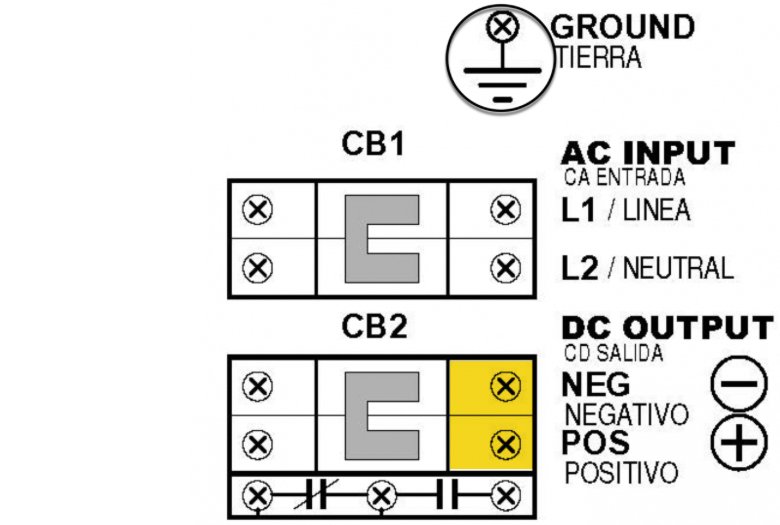Installer is responsible to provide suitable dc output, battery, and dc load wiring.
Follow these steps to connect the battery to ATevo:
- Size the dc wiring to minimize voltage drop. Acceptable wire size depends on the installation. As a guideline, voltage drop should not exceed 1% of nominal output voltage at full current. Refer to the following table to determine the voltage drops for various wire sizes, currents and distances.
| Wire Sizing Chart | |||||
|---|---|---|---|---|---|
| Voltage Drop per 100ft / 30.5m of Wire (for copper at 68 F / 20 C) | |||||
| Wire Size (AWG) | DC Current (Amperes) | ||||
| 6 | 12 | 16 | 20 | 25 | |
| 16 | 2.5V | 5.0V | 6.7V | 8.2V | 10.5V |
| 14 | 1.6V | 3.2V | 4.2V | 5.3V | 6.6V |
| 12 | 1.0V | 2.0V | 2.6V | 3.3V | 4.2V |
| 10 | 0.63V | 1.3V | 1.7V | 2.1V | 2.6V |
| 8 | 0.40V | 0.80V | 1.1V | 1.3V | 1.7V |
| 6 | 0.25V | 0.50V | 0.66V | 0.83V | 1.1V |
| 4 | 0.16V | 0.32V | 0.42V | 0.52V | 0.65V |
Example: 100ft / 30.5m of #8 AWG wire at 16A has a 1.1V drop.
- ATevo is factory wired to regulate output voltage at the output terminals. If total voltage drop is greater than 1% (e.g. 1.3V for a 130 Vdc system), remote sense wiring is recommended (see Section 11, Remote Sense ).
- Do not run external ac and dc power wiring through the same conduit.
- Facility-specific installation requirements take precedence.
I/O Connections: Style-5054 Enclosure
PROCEDURE
- Use a dc disconnect switch or circuit breaker between ATevo and the dc bus. This device should have lockout capability to allow ATevo to be disconnected from the dc bus for maintenance.
- Remove safety shield (see Section 2.2, Removing Protective Safety Shield).
- Run dc wiring to Output Circuit Breaker (CB2).
- Connect wires to appropriate locations on the DC Output Breaker (CB2+/-) as indicated on drawing above.
- Using a flat-blade screwdriver, securely tighten compression screws on DC Output Breaker Terminals (CB2+/-).
- Reinstall safety shield after you have made and checked all connections.
Last modified:
27 September 2023
Need more help with this?
Don’t hesitate to contact us here.



